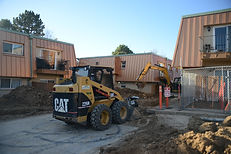
According to Wikipedia, adaptive reuse refers to the process of reusing an existing building for a purpose other than that for which it was originally built or designed.
Adaptive reuse has been lauded for its ability to save historically significant structures, maintain historical neighborhood context, conserve natural resources, and minimize construction-related disruptions to neighborhoods. But from a purely practical perspective, it can possibly provide a much lower cost construction option. But before jumping into an adaptive re-use project, several factors must be seriously considered.
Does your building’s structure lend itself to adaptive reuse? Can you take your office building that has systems at the end of their life cycle, and rather than just replacing the systems, does the structure allow a new layout for one-bedroom affordable apartments?
At Denver Housing Authority’s Thomas A. Connole apartments, Pinkard stripped the building down to its concrete skeleton and built 10-story-tall exterior structural concrete walls to convert the 50-year-old building from studio apartments into one- and two-bedroom units. For the City and County of Denver’s Minoru Yasui Plaza project, the former Downtowner Motor Inn was converted into office space. There, Pinkard did comprehensive interior renovations that included installation of a state-of-the-art European hydronic heating system. Both adaptive reuse projects won national acclaim for their creativity and construction excellence.

And then there is asbestos abatement, lead-based paint, and aluminum wiring, all of which can break a budget at the start. Denver’s Green Roof Initiative? If you’re putting on a new roof you may be required to include a green roof or a combination of green roof and solar energy collection – both pricey additions.
The condition of the exterior skin must also be considered – replacement can complicate construction with time-consuming scaffolding systems and street closures. HVAC systems are typically the highest-cost systems. Compromises in the wrong way will have end users complaining to management on a weekly basis.
Will zoning support your intended purpose? Can you go from office space to mixed-use retail/residential and meet parking requirements? What is the required cars-per-thousand-square-feet ratio to support retail and/or residential use? Chances are your office building may not meet that.
Regardless of the quality of a building’s as-built drawings (if you even have any?) and the level of due diligence, you can be assured that you will run into unforeseen conditions that stall your schedule and take precious dollars out of your budget over and above the 10% contingency allowance most lenders require. Every contractor can provide a long litany of owner/architect/contractor unforeseen condition woes, with a corresponding array of schedule delays and cost increases. Fortunately, there are ways to greatly improve your chances of success.
Dedicated collaboration and teamwork can avert potentially disastrous outcomes, and this of course speaks volumes about how you should select your team partners. Your contractor, architect and engineers should have considerable experience with complicated renovations and excellent team skills, and your contractor’s preconstruction team should have a great record of providing accurate estimates for these types of renovations.
It’s always best to take a conservative approach when estimating a complex adaptive reuse. Sometimes owners begin with very tight budgets and a huge potential for unforeseen conditions. This makes for a very problematic preconstruction phase, with considerable budgetary headaches and possibly slashing scope. At that point your exciting dream project can become something of a nightmare. It’s also important to be sure that your team’s budgets include ample contingencies and allowances, and that the use of these tools is clearly spelled out.
Early in the budgeting phase, Pinkard typically starts with a higher contingency load based upon our custom risk log for your project. For example, if there is asbestos, aluminum wiring, and the windows and HVAC need to be replaced, those factors pretty much dictate your costs. But we can start eliminating the unknowns through testing, exploration, and collaboration with major subcontractors and engineers. 3D laser scanning, ground penetrating radar to scan post-tensioned slabs, basic non-destructive investigations, etc. all combine to provide a better understanding of the many variables that may affect an owner's budget.
Pinkard President Tony Burke observes that “Laser scanning is a recent technology our teams are using with great success. It is making a dramatic difference in our abilities to measure every inch of a building to create more constructable designs and more predictable construction plans. The data is uploaded into a building information technology platform. Designers use this data to create more exacting layouts with greatly reduced risk of clashes and layout busts. And the cost/benefit ratio of this technology is overwhelmingly favorable.”
A better understanding of risk allows for a reduction in contingency. Pinkard shares this information with the entire team to fully inform the owner. In many cases, with this data, an owner/architect/contractor team should have enough information to manage risk and allow a project to move forward.
Every building is adaptable, but not every adaptation is affordable. Put a lot of thought and care into selecting a trusted and responsible team to help you sort through all the details. It is the shortest and best path to a wise decision.









